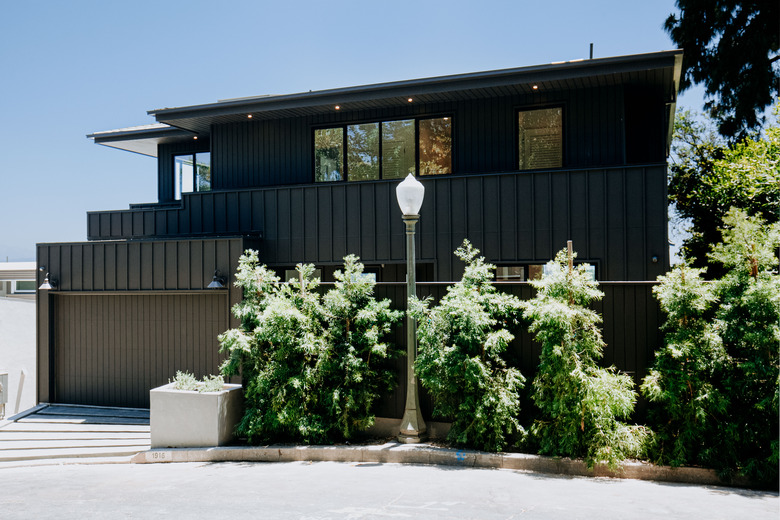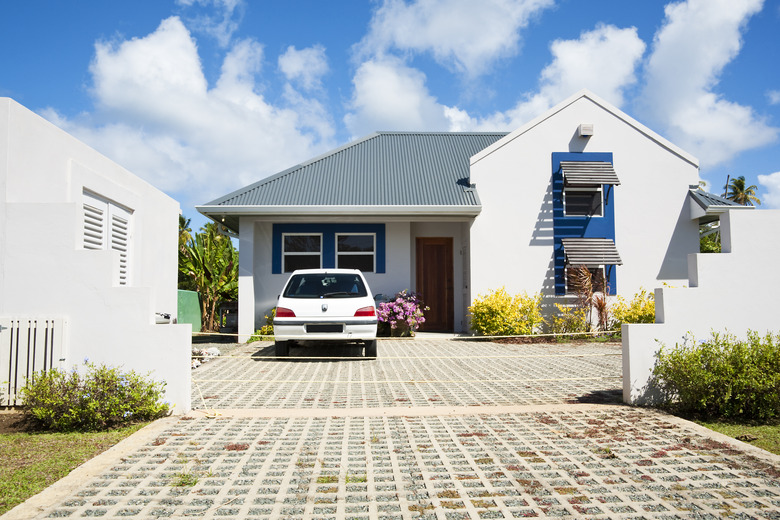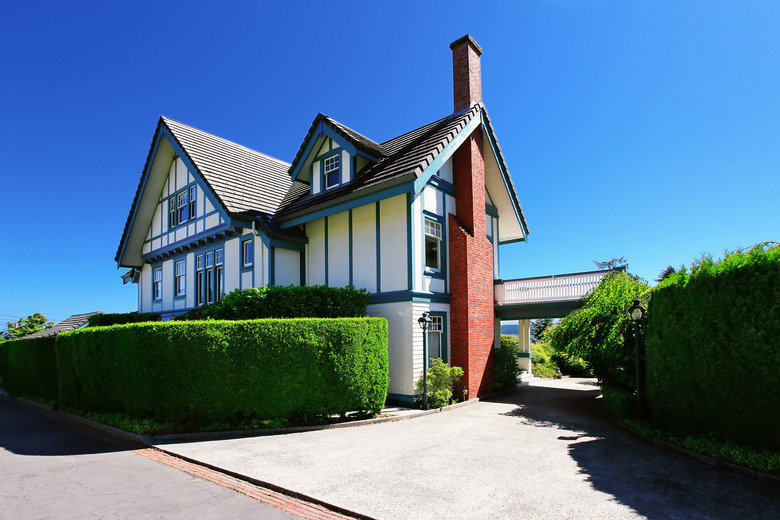A DIY Guide To Planning A Driveway
We may receive a commission on purchases made from links.
It's a bit of a stretch to DIY your own driveway because you usually need heavy equipment, but you can and should do the planning yourself because a driveway has to serve your needs, and it's a central element in your home's landscape. Besides providing vehicle access and a parking area, a driveway is a real-estate investment that has a huge effect on your home's curb appeal.
A large number of factors will affect your decision, not the least of which are local ordinances that may govern the design, size, grade and/or materials. You'll have to apply for a driveway permit, and the permit requirements of the Town of Washburn, Wisconsin provide an example of some of the ones you may have to consider. Even if you fulfill all the rules found in your local ordinances, your plans to cut any trees to make way for your new driveway may run afoul of local conservation bylaws, so check those too. If you hope to do the work yourself, it's a good idea to have your plan checked by a licensed contractor before you submit it to the permitting authority to save yourself the headache of multiple revisions.
Aesthetics Provide a Good Starting Point
Aesthetics Provide a Good Starting Point
You may have built a new freestanding or add-on garage so close to the road that the driveway needs to be little more that a short, straight thoroughfare between them, and in that case, the choice of material is your main concern. If the driveway is longer than about 100 feet, though, and you want to add a parking area near your house, there are good aesthetic reasons to consider adding curves. A driveway that meanders through the landscape — if it's cost effective to build one — is more visually interesting than one that stretches in a straight line from point A to point B.
The choice of driveway material is primarily a functional one because some materials may not be appropriate depending on grade and drainage, but it's also an aesthetic one. The same is true for the landscape features that border the driveway. You may choose to install border pavers, or if you like your privacy, you might line the driveway with hedges. Drainage is often an issue along the border of a driveway, so you might need to install a French drain or swale, and that creates a perfect growing area for grass or ground cover.
Like choosing a color when painting the house or placing landscape features, designing a driveway should be done with an eye to the neighborhood. Just as a gravel driveway might look out of place in an upscale neighborhood, a stamped, stained and polished concrete driveway may not blend well in a semirural area. If your driveway harmonizes with the surroundings, your house probably will too.
4 Common Driveway Materials
4 Common Driveway Materials
You have your choice of more than four driveway materials — EuroPaving lists nine — but many specialty materials aren't available everywhere, and some, like basalt and cobblestone, can be quite pricey. The four most common materials are concrete, asphalt, gravel (which includes crushed stone) and pavers (which includes both bricks and concrete pavers). They vary in price, appearance, durability, maintenance requirements and eco-friendliness.
- Concrete: Costing about $6 per square foot to install, a concrete driveway is solid and waterproof, but the production of cement (an essential ingredient of concrete) creates greenhouse gases, so concrete is not a very eco-friendly choice. A plain concrete driveway doesn't offer much visual appeal, but you can improve this by stamping or staining it. According to the Washington Post, a concrete driveway can be expected to last from 25 to 50 years.
- Asphalt: A petroleum product, asphalt definitely isn't an eco-friendly material, and because it absorbs heat, an asphalt driveway can be painful to walk on during the summer. Costing between $2 and $5 per square foot, it's a cheaper alternative to concrete, but its expected life is only 12 to 20 years, and it requires periodic sealing.
- Gravel: As the least expensive driveway option, gravel costs from $1 to $3 per square foot to install — slightly more if you use crushed rock — so it's a natural choice for a long driveway, especially one in a rural setting. Gravel lasts as long as 100 years, but a gravel driveway will need to be regraded every few years, and more gravel will have to be added to replace the material that washes away.
- Pavers: Pavers can last as long as concrete, but at $15 to $30 per square foot, a paver driveway costs several times as much to install, although you can reduce costs significantly ($5 to $10 per square foot) by using new or recycled bricks. Pavers last about 25 years and are relatively maintenance-free, requiring only the occasional cleaning with a pressure washer.
Driveway Topography Considerations
Driveway Topography Considerations
The lay of the land often forces design decisions you might not otherwise make. For example, the maximum slope should be about 15 percent, which means that the driveway rises no more than 15 feet over a 100-foot horizontal distance, and some communities, such as the town of Washburn, reduce this maximum to as little as 10 percent. If you're building a driveway on a steep hill, you may have no choice but to make it curved to keep the slope below the maximum allowed.
A driveway ideally slopes away from the house, and when this is impossible, there's a danger of flooding around the garage or entryway. One solution to address this problem is trench drains that extend across the driveway surface to catch water. Another solution is swales, which are wide ditches that border the driveway to catch runoff and allow it to seep into mulch or into the surrounding landscape. In addition, Landscaping Network suggests using a water-permeable driveway material, such as pavers, gravel or flagstone.
Runoff quickly deteriorates many driveway materials, and on steep hillsides, one or more culverts—or pipes installed under the roadway that help with drainage—may need to be installed. Some communities (again referring to Washburn as an example) place limitations on their minimum diameter and length. Your community may also place a limit on the width of the driveway, although you should be safe if you make it a standard 12 feet wide.
DIY Driveway Installation
DIY Driveway Installation
For a driveway installation, you need heavy machinery for all but the shortest driveways. After staking out the borders, installation begins with excavating to a depth of 4 to 6 inches depending on the driveway surface material, tamping with a plate compactor, spreading drain rock and tamping that to form a solid subsurface for the actual driveway material. If culverts are needed, trenches must be dug, and because culverts are typically 12 to 18 inches in diameter, digging the trenches and laying the culverts are jobs for an excavator.
DIYers, like pros, typically have no recourse but to call in contractors with the equipment to do these jobs as well as the trucks necessary to haul in drain rock, sand, concrete, asphalt, gravel and other materials. None of this sounds like a DIY project, and it isn't, but DIYers can get their hands dirty spreading sand and laying concrete pavers or a cobblestone driveway, digging drainage trenches, raking gravel and edging the finished driveway. Pouring a concrete slab and laying asphalt, however, are jobs best left to pros with the expertise and the equipment to do the job correctly.
Most Driveways Need Maintenance
Most Driveways Need Maintenance
Maintenance is an important issue to consider when planning a driveway because while no driveway material is maintenance-free, some require more than others. TRUEGRID identifies brick and concrete pavers as some of the least maintenance-intensive materials, needing little more than occasional washing. If a paver cracks, you can easily replace it yourself.
- Concrete: Concrete driveways last for years, but concrete can crack because of shifting soil or poor drainage. You can fill small cracks with caulk-like patching materials that come in tubes, and you fill larger cracks with mortar. Patched cracks remain visible, and resurfacing may be needed when numerous patches ruin the appearance of the driveway. Concrete resurfacing is a DIY project you can accomplish with a resurfacing compound and a squeegee.
- Asphalt: Asphalt driveways can also crack, but they can develop potholes and depressions known as sink holes or, because the holes collect water, bird baths. The remedy for all these problems is cold patch, an asphalt-repair product available at most home improvement outlets. You basically trowel it onto the driveway, filling the crack or hole, and compress it using a plate compactor or by driving over it with your car.
- Gravel: A gravel driveway may be the least expensive to install, but it requires the most maintenance. A certain amount of gravel gets displaced every time a car travels on it, and rainwater washes even more to the side of the driveway, leaving the dirt subsurface exposed and vulnerable. Ruts and potholes that need to be filled are common, and the driveway needs to be periodically graded and replenished with gravel. Depending on the length of the driveway, annual maintenance costs can easily run into four figures, although you can reduce these by filling ruts and potholes yourself.
The Driveway Less Traveled
The Driveway Less Traveled
An easy way to reduce maintenance on a gravel driveway is to install a plastic grid to hold the gravel in place. This type of system isn't as common as some other driveway materials, but perhaps it should be. It creates a permeable driveway that drains easily and efficiently, and it can outlast a driveway made of concrete or asphalt. The grid, which is made of recycled materials, consists of interlocking paver-shaped openings that you can fill with sand and top off with gravel, and it can be used in conjunction with other driveway materials to help control runoff.
The grid itself is made from recycled plastic, which makes it an environmentally friendly driveway material, and paving materials like sand and gravel don't significantly increase the carbon footprint. In fact, you can fill the grid with crushed concrete or some other recycled material in lieu of gravel and actually reduce the carbon footprint. One of the more creative options is to fill the grid with grass to create a driveway that doesn't look like a driveway.
Because the grid is filled with permeable paving, it's unlikely to flood and is a perfect option when you have to install your driveway on a poorly draining part of the property. However, it's not the best option if you live in a snowy climate and need to shovel or plow the driveway frequently.
This type of driveway can be as close to a maintenance-free driveway as you'll be able to find, although if you fill the grid with grass, you may have to mow occasionally with a string trimmer. A grid driveway may not add as much visual appeal as stamped concrete or a brick driveway, but it's an inexpensive, easy-to-install system that's bound to get the neighbors talking.


